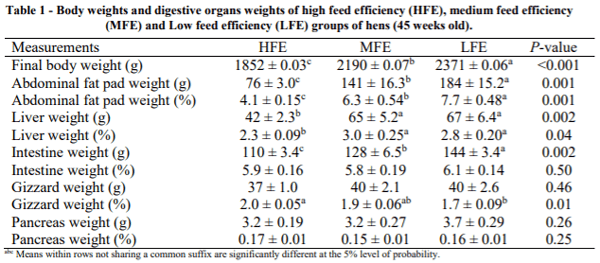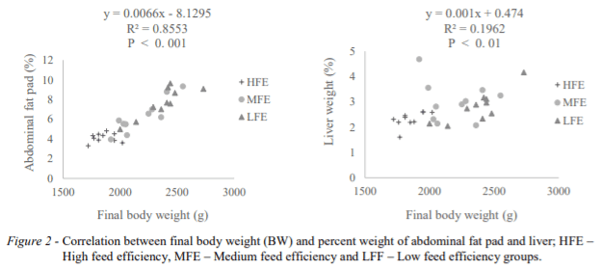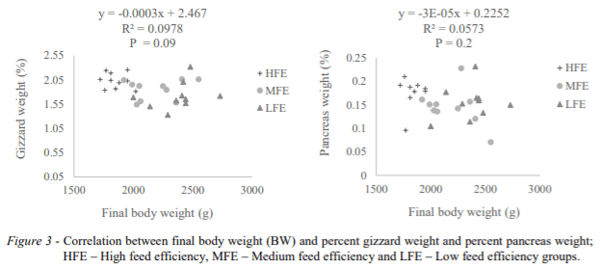I. INTRODUCTION
The feed efficiency (FE) of commercial laying hens has improved steadily since genetic selection began in earnest, with modern hybrids converting approximately 2.1 kg of feed into 1 kg of eggs. Recent research suggests considerable variation in FI and FE between hens kept under common management and dietary conditions (Akter et al., 2018). Research also indicates that many factors affect FE, including body composition, the digestion and metabolism of nutrients, energy output, body activity and body temperature regulation (Herd and Arthur, 2009). However, there is little information describing the BW and digestive organ of individual hens and how these contribute to variation in flock FE. The aim of this study was to determine the associations of BW with FI, FCR and digestive organ parameters in ISA brown commercial laying hens.
II. MATERIALS AND METHODS
This work was conducted at the Poultry Research Facility, University of Sydney, Camden. All procedures used in this study were approved by the Animal Ethics Committee of the University of Sydney. All birds were housed individually in 25 × 50 × 50 cm cages for 6 weeks to facilitate individual weekly FI, daily EP and EM. After the initial screening phase, 150 hens (35 weeks of age; HFE, MFE and LFE; 50 hens/group) were selected from a total 450 individually housed hens. The experimental diet (wheat and soybean meal-based mash) consisted of 16.3% CP, 2,750 kcal/kg ME. Body weight for all individual bird was recorded at the start and end of the study period (35 to 41 weeks of age). FCR was calculated from weekly EP and FI over 6 weeks to verify the FE of each group. Ten birds from each of the HFE, MFE and LFE groups (n = 30) were randomly selected from a total 150 birds and euthanised by intravenous injection of Na pentobarbitone. The abdominal fat pad, liver, pancreas, gizzard and whole intestine were excised and weighed accordingly. Data were analysed using the generalised linear model procedure of SAS (SAS Institute) with FE group as the main effect. All data are presented as least square means ± standard error of the mean (SEM). Means were separated using the Tukey-Kramer method Pearson or Spearman correlation coefficients output for production traits and egg quality measurements was generated using the proc corr procedure SAS Institute Inc. The probability value which denotes statistical significance was P < 0.05.
III. RESULTS AND DISCUSSION
The results of this study indicate that final BW of hens was moderately correlated with FI (r = 0.63, P = 0.002; Figure 1) and FCR (r = 0.44, P < 0.01; Figure 2). This clearly supports the proposition that the more feed hens eat, the heavier they become and the higher their inefficiency to convert feed to eggs. This finding agrees with the findings reported in laying hens divergently selected for HFE and LFE (Nolan et al., 2018).
The final BW and weight of the digestive organs is presented in Table 1. The final BW (P < 0.001) and both abdominal fat pad weight (P < 0.001) and percent weight of abdominal fat pad (P < 0.001) were higher in LFE. The weight of the liver and percent liver weight were lower (P = 0.002; P = 0.04) in HFE group while the percent weight of gizzard was higher (P < 0.001) in the HFE than in the LFE group (Table 1).

The results of correlation analysis indicated that BW showed a strong positive correlation with the percent weight of abdominal fat pad (r = 0.95, P < 0. 001; Figure 3). A moderate correlation was found between final BW and percent liver weight (r = 0.44, P < 0.01) of birds while a slight negative correlation was noticed between final BW and percent gizzard weight (r = - 0.31, P = 0.09; Figure 5) and percent pancreas weight (r = - 0.24, P = 0.2; Figure 6). Body weight differences are largely a reflection of differing amounts of fat. In agreement with the current study, Carre et al. (2008) reported that LFE birds had greater fat deposition in the body and were 13% more inefficient than efficient birds. Research indicated that the size of internal organs is related to FI (Johnson et al, 1990), as the energy expenditure of these organs increases after feeding and is dependent on FI (Seal and Reynolds, 1993).

In this study, higher gizzard weight proportion to body weight in the HFE group suggests that the birds which have been specifically selected for HFE are genetically predisposed to growing a large gizzard.
IV. CONCLUSION
The present study indicates that HFE hens clustered in the body weight range of 1750 to 2000 g are leaner, have smaller liver and heavier gizzard in proportion to their BW. Smaller liver could be related to lower energy consumption and slower metabolic rate while bigger gizzard probably leads to greater nutrients availability in the small intestine which seems related to greater FE in the HFE hens. Clearly, hens in the upper end of the BW distribution are predictably inefficient and managerial efforts must be made to reduce the proportions of these birds within flocks to improve economic performance.
ACKNOWLEDGEMENTS: The authors gratefully acknowledge the Australian Eggs for providing funding for this study. The authors also thank Ms. Joy Gill, Ms. Melinda Hayter, Mr. Duwei Chen, & Ms. Kylie Warr for providing technical support to carry out this study.
Abstract presented at the 30th Annual Australian Poultry Science Symposium 2019. For information on the latest edition and future events, check out https://www.apss2021.com.au/. 













.jpg&w=3840&q=75)